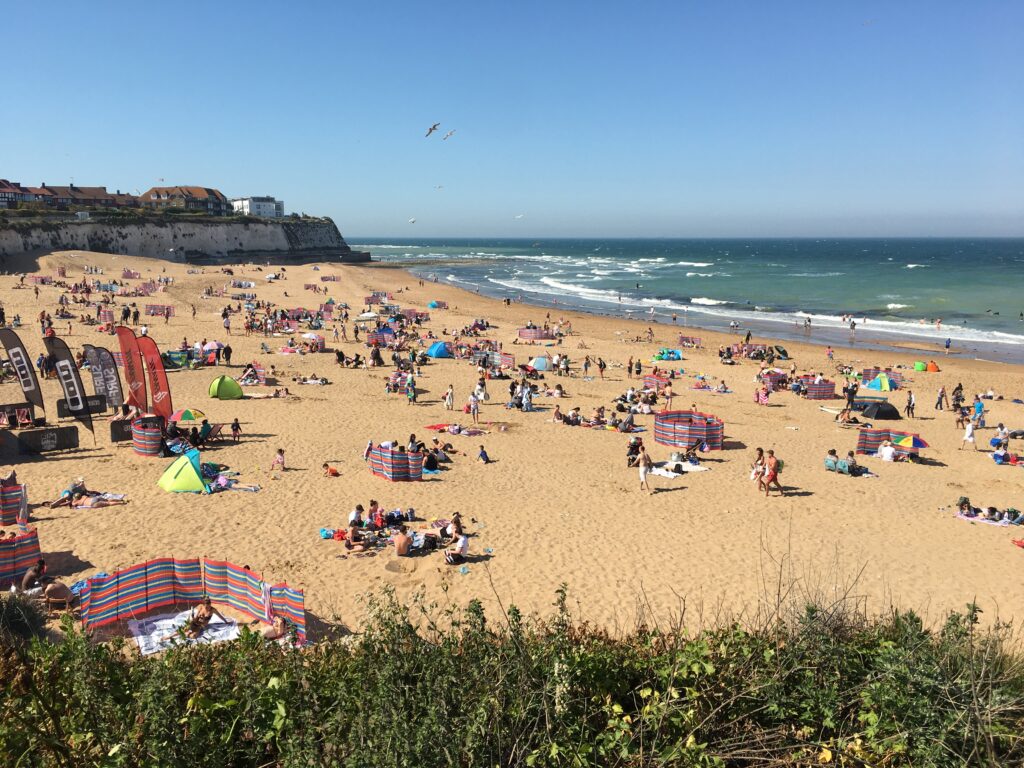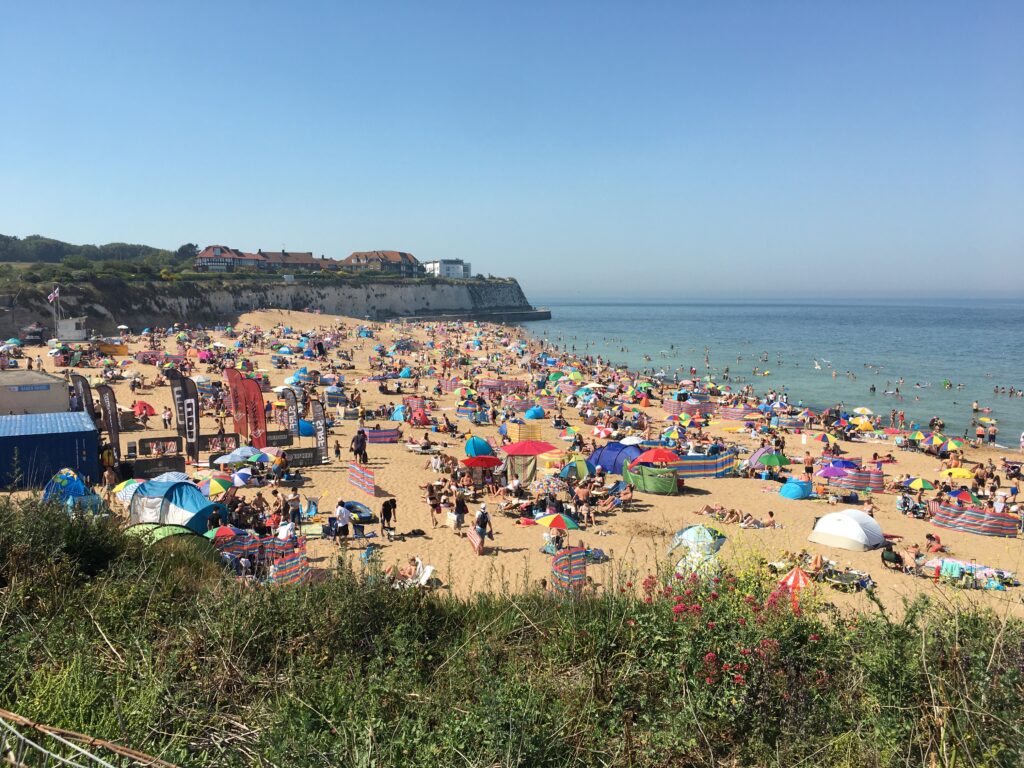

On Monday the Prime Minister, Boris Johnson, happily announced a tranche of relaxations of England’s lockdown restrictions, to be timed for 4 July. The public weren’t going to wait, flocking to the country’s beaches to take advantage of a few days of sunshine. I took the first picture here in Broadstairs, Kent on 31 May, thinking it was crowded (we had become used to this beach being deserted), but look at yesterday by comparison. The country seems to be making a dash for normality. Disappointment lies ahead.
The relaxations come after some hefty lobbying by businesses, who are experiencing huge strains. They highlight a legitimate concern, as many jobs are under threat as businesses face the danger of folding. Public finances are under strain too, though by how much and why remains a matter for debate. But the problem is a deadly virus for which there is no vaccine or cure, not overzealous lockdown regulations. So if you don’t want to risk catching the disease, and the prospect of a horrible death, just how safe are you being made to feel? The country is dividing on this question.
I have heard quite a few lobbyists for the hospitality industry on the radio. For the most part they do not inspire confidence. They are anxious to abolish the two-metre social distancing rule, but are reluctant to explain how they can still be safe. Some of them even grumble about the idea that they would have to keep records of all those attending their establishments, even though this is an obvious quid quo pro to relaxing distancing requirements in the high-risk settings that most of them obviously run. One expert offered a list of potential mitigations for reduced distancing: not facing people, masks, reducing time of contact, low noise levels so that people can talk softly. Not much of this helps if you are indoors in a pub or restaurant, although if customers are seated at tables only with members of their isolation group, then at least you won’t be facing others. To be fair some hosts on television are doing a better job of explaining themselves: instead of whinging about the rules they are showing viewers all the precautions they are taking to make people feel safe.
But a lot of people don’t really care. They are fed up with confinement, and note the reduced prevalence of the disease, and therefore the reduced risk of catching it. Many are younger and fitter people who feel less at risk of suffering badly. Many also draw confidence from other countries where restrictions have been relaxed. They miss two aspects of these overseas examples. First is that in the more successful countries they applied relaxation after they had beaten back the disease further than England has, and that even then they have had to identify and manage local outbreaks. And England’s track and trace infrastructure inspires little confidence that it is up to this task. The second is that in other countries that have relaxed (notably in some states of the USA), they are moving headlong into a relapse. Two things about the epidemic strain our intuitive way of understanding the world. First is the time lag between picking up the disease and diagnosing it, then between diagnosis and hospitalisation, and finally between hospitalisation and death. The second is the exponential nature of the spread, and the way a small number moves very rapidly to a big one and so the need to intervene when it feels too early. This is what led to some countries failing to take the disease seriously enough until too late. It is clear that the US President Donald Trump, ever the intuitive leader, struggles with both these things.
But while one, very conspicuous, group are making a headlong dash for normality, another, usually older and more vulnerable, group remain very frightened. They are staying indoors, so remain nearly invisible. But this applies to my household and many others that I know. This is both good and bad news. The good news is that if this group stays out of trouble, then the most vulnerable people will be protected, keeping hospitalisations and death rates down. The bad news is that this large number of often quite high-spending people will not be the free-spending agents needed for a full economic recovery. And if infection rates start to rise, they will become even more scared.
All of which gives an impressive of a government that doesn’t think things through. If it wanted to tempt older people back into shops and other facilities it needed to work a bit harder to reassure them. The words are there but the body-language isn’t. For example the government says that the 2-metre rule is replaced by “one-metre plus”. The plus is meant to suggest alternative mitigation, and yet this has been totally drowned out in the messaging. If it had been combined with a clear directive for people to wear face coverings in virtually all indoor settings, then it might have been easier to convey this. Instead they promote the idea that the risks are reduced so you don’t need precautions like masks; of course they don’t say that, but observing people around me that seems to be what is happening. And the problem about masks is that everybody needs to wear them for it to work. It is no use if just the worried people do.
Still, the government has probably bought itself a month or two before any obvious problems emerge. And then it looks likely to face a twin threat. A faltering economy as the worried sit on their savings while government support schemes, like furlough funding, run their course. And rising infection rates working their way slowly but surely through the system, beyond the country’s capacity to contain it on a local level. I really hope I’m wrong.
With all due respect, I am approaching 70 as our many of my friends and we have not retreated to our bunkers for the last 3 months, but have rather continued with our lives only interupted by the imposed changes such as businesses forced to close.
The reality is that we will never be safe from viruses, and the naivety that we will have a vaccine soon is ludicrous, we still don’t have an HIV vaccine after 30 years, and more importantly this government or any government is never going to say it is 100% safe, because it never will be, and it never can be.
The choice therefore is you hide in your cupboards for the rest of what will be a pretty miserable live, or you make a decision for yourselves, and accept the consequences of that decision.
It is simply as that choose to live your life, or chose to exist, but ultimately it is your choice, and not the responsiblity of trhe vast majority of the population who have made that choice, and have chosen freedom.
Thanks for the comment Tom, but I disagree. Covid-19 is a lot deadlier to older people than the other viruses out there, and does its work in a particularly nasty way. With properly organised controls risk levels can be kept moderate, and, I am told, we are somewhat more likely to find a vaccine for this one than many other diseases. The trouble is that keeping the disease at acceptable levels, absent a vaccine, requires a certain amount of civic good behaviour from those less likely to die, but who could be transmitters. My worry is that in America and Britain we don’t have that level of public spiritedness. East Asian countries (Japan, Taiwan, South Korea, for example) seem to have found a much better balance? So I don’t see this as a choice between life and freedom.
I too am expecting the number of infections to start rising again; it seems to me that the under- 50s in a normal healthy state will realise that they personally are in no real risk of dying, and that in these circumstances, observance of the recommended precautions will not be strict. Whether the Government will do enough in response to stop the infection spiralling out of control is anyone’s guess. Until we get a vaccine, perhaps the best one can hope for is improved shielding of the elderly and other vulnerable groups, who can then at least socialise a bit amongst themselves; together with the keeping of the death rate to a substantial but not totally intolerable level on this basis. The political fall-out from such a situation seems unlikely to be favourable to a Government which already has difficult Brexit issues as yet unresolved.
“And the problem about masks is that everybody needs to wear them for it to work. It is no use if just the worried people do.”
This isn’t strictly speaking true. The more they are worn the more effect they have but it doesn’t mean everyone has to wear them.
We hear similar mis-reasoning about vaccines. It won’t be disastrous if they don’t work as well as we would like. Perhaps they might not work on the very elderly. Neither does it matter too much if a certain number of the population don’t wish to be vaccinated providing it’s not too large a number. The R rate will fall dramatically by protecting the younger population and those who do choose to be vaccinated. Therefore the virus will be hindered in its replication process. This will lead to its elimination which will of course help protect the elderly and the unvaccinated.
The same with tests. One test was rejected because, as I understand it, it was ‘only’ 95% accurate. That’s pretty good! Certainly good enough to help push R well below 1.
So I wouldn’t share your pessimistic outlook. We should be OK, from now on, providing we maintain sensible precautions. “OK” will still involve more deaths in the next year or so. It won’t be a complete victory but at least the NHS should hold up and be able to cope. Having said that, the danger time will be later in the year as the colder weather sets in and we retreat inside without opening our windows!